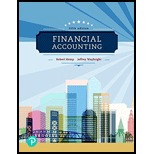
Financial Accounting (5th Edition) (What's New in Accounting)
5th Edition
ISBN: 9780134727790
Author: Robert Kemp, Jeffrey Waybright
Publisher: PEARSON
expand_more
expand_more
format_list_bulleted
Concept explainers
Question
Chapter 7, Problem 7SE
To determine
Compute the Person M’s balance of accounts receivables on October 31. State the possibilities of collecting the entire amount and explain the reasons.
Expert Solution & Answer
Want to see the full answer?
Check out a sample textbook solution
Students have asked these similar questions
General accounting
Assume that all dividends general accounting declared were actually paid
Calculate the net income general accounting consider the information
Chapter 7 Solutions
Financial Accounting (5th Edition) (What's New in Accounting)
Ch. 7.A - Prob. 1SECh. 7.A - Prob. 2SECh. 7.A - Prob. 3AECh. 7.A - Prob. 4AECh. 7.A - Prob. 5BECh. 7.A - Prob. 6BECh. 7.A - Prob. 7APCh. 7.A - Prob. 8BPCh. 7 - Which duties should be segregated in the...Ch. 7 - Prob. 2DQ
Ch. 7 - Prob. 3DQCh. 7 - Why does the allowance method of accounting for...Ch. 7 - Prob. 5DQCh. 7 - Prob. 6DQCh. 7 - Prob. 7DQCh. 7 - How would the net realizable value of Accounts...Ch. 7 - Prob. 9DQCh. 7 - Prob. 10DQCh. 7 - Prob. 1SCCh. 7 - Prob. 2SCCh. 7 - Prob. 3SCCh. 7 - Prob. 4SCCh. 7 - Prob. 5SCCh. 7 - Prob. 6SCCh. 7 - Prob. 7SCCh. 7 - Prob. 8SCCh. 7 - Prob. 9SCCh. 7 - Prob. 10SCCh. 7 - Prob. 11SCCh. 7 - Prob. 12SCCh. 7 - Prob. 1SECh. 7 - Prob. 2SECh. 7 - Prob. 3SECh. 7 - Prob. 4SECh. 7 - Prob. 5SECh. 7 - Prob. 6SECh. 7 - Prob. 7SECh. 7 - Prob. 8SECh. 7 - Prob. 9SECh. 7 - Prob. 10SECh. 7 - Prob. 11SECh. 7 - Prob. 12SECh. 7 - Prob. 13SECh. 7 - Prob. 14SECh. 7 - Prob. 15SECh. 7 - Quick ratio (Learning Objective 7) 510 min....Ch. 7 - Prob. 17SECh. 7 - Prob. 18AECh. 7 - Prob. 19AECh. 7 - Prob. 20AECh. 7 - Prob. 21AECh. 7 - Prob. 22AECh. 7 - Prob. 23AECh. 7 - Prob. 24AECh. 7 - Prob. 25AECh. 7 - Prob. 26AECh. 7 - Prob. 27AECh. 7 - Quick ratio and current ratio (Learning Objective...Ch. 7 - Prob. 29AECh. 7 - Prob. 30BECh. 7 - Prob. 31BECh. 7 - Prob. 32BECh. 7 - Prob. 33BECh. 7 - Prob. 34BECh. 7 - Aging of accounts receivable allowance method...Ch. 7 - Prob. 36BECh. 7 - Prob. 37BECh. 7 - Prob. 38BECh. 7 - Prob. 39BECh. 7 - Quick ratio and current ratio (Learning Objective...Ch. 7 - Prob. 41BECh. 7 - Prob. 42APCh. 7 - Prob. 43APCh. 7 - Prob. 44APCh. 7 - Prob. 45APCh. 7 - Prob. 46APCh. 7 - Accounting for notes receivable (Learning...Ch. 7 - Prob. 48APCh. 7 - Prob. 49BPCh. 7 - Prob. 50BPCh. 7 - Prob. 51BPCh. 7 - Prob. 52BPCh. 7 - Prob. 53BPCh. 7 - Prob. 54BPCh. 7 - Prob. 55BPCh. 7 - Continuing Exercise In this exercise, we continue...Ch. 7 - Prob. 1CPCh. 7 - Prob. 1CFSAPCh. 7 - Prob. 1EIACh. 7 - Prob. 2EIACh. 7 - Financial Analysis Purpose: To help familiarize...Ch. 7 - Industry Analysis Purpose: To help you understand...Ch. 7 - Prob. 1SBACh. 7 - Prob. 1WC
Knowledge Booster
Learn more about
Need a deep-dive on the concept behind this application? Look no further. Learn more about this topic, accounting and related others by exploring similar questions and additional content below.Similar questions
- General accountingarrow_forwardDon't use ai given answer accountingarrow_forwardMoonWear, Inc. offers an unconditional return policy. It normally expects 2.5% of sales at retail selling prices to be returned before the return period expires. Assuming that MoonWear records total sales of $12.5 million for the current period, what amount of net sales should it record for this period?arrow_forward
arrow_back_ios
SEE MORE QUESTIONS
arrow_forward_ios
Recommended textbooks for you
 Financial AccountingAccountingISBN:9781337272124Author:Carl Warren, James M. Reeve, Jonathan DuchacPublisher:Cengage LearningPrinciples of Accounting Volume 1AccountingISBN:9781947172685Author:OpenStaxPublisher:OpenStax College
Financial AccountingAccountingISBN:9781337272124Author:Carl Warren, James M. Reeve, Jonathan DuchacPublisher:Cengage LearningPrinciples of Accounting Volume 1AccountingISBN:9781947172685Author:OpenStaxPublisher:OpenStax College- Century 21 Accounting Multicolumn JournalAccountingISBN:9781337679503Author:GilbertsonPublisher:Cengage

Financial Accounting
Accounting
ISBN:9781337272124
Author:Carl Warren, James M. Reeve, Jonathan Duchac
Publisher:Cengage Learning

Principles of Accounting Volume 1
Accounting
ISBN:9781947172685
Author:OpenStax
Publisher:OpenStax College


Century 21 Accounting Multicolumn Journal
Accounting
ISBN:9781337679503
Author:Gilbertson
Publisher:Cengage
Accounts Receivable and Accounts Payable; Author: The Finance Storyteller;https://www.youtube.com/watch?v=x_aUWbQa878;License: Standard Youtube License